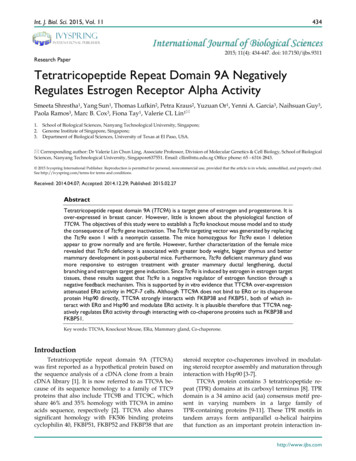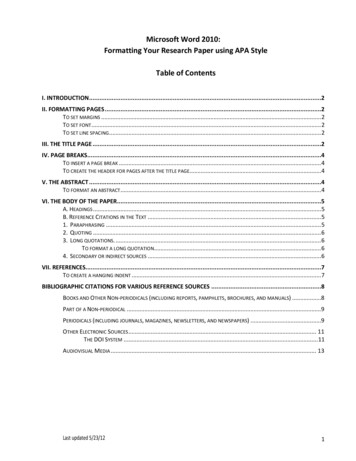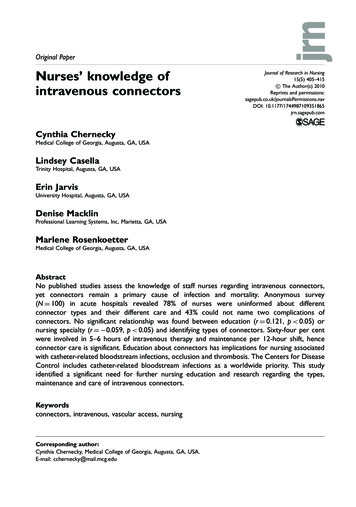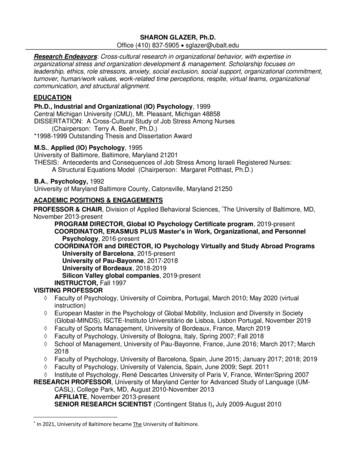
Transcription
Int. J. Biol. Sci. 2015, Vol. 11IvyspringInternational Publisher434International Journal of Biological Sciences2015; 11(4): 434-447. doi: 10.7150/ijbs.9311Research PaperTetratricopeptide Repeat Domain 9A NegativelyRegulates Estrogen Receptor Alpha ActivitySmeeta Shrestha1, Yang Sun1, Thomas Lufkin2, Petra Kraus2, Yuzuan Or1, Yenni A. Garcia3, Naihsuan Guy3,Paola Ramos3, Marc B. Cox3, Fiona Tay1, Valerie CL Lin1 1.2.3.School of Biological Sciences, Nanyang Technological University, Singapore;Genome Institute of Singapore, Singapore;Department of Biological Sciences, University of Texas at El Paso, USA. Corresponding author: Dr Valerie Lin Chun Ling, Associate Professor, Division of Molecular Genetics & Cell Biology, School of BiologicalSciences, Nanyang Technological University, Singapore637551. Email: cllin@ntu.edu.sg Office phone: 65 - 6316 2843. 2015 Ivyspring International Publisher. Reproduction is permitted for personal, noncommercial use, provided that the article is in whole, unmodified, and properly cited.See http://ivyspring.com/terms for terms and conditions.Received: 2014.04.07; Accepted: 2014.12.29; Published: 2015.02.27AbstractTetratricopeptide repeat domain 9A (TTC9A) is a target gene of estrogen and progesterone. It isover-expressed in breast cancer. However, little is known about the physiological function ofTTC9A. The objectives of this study were to establish a Ttc9a knockout mouse model and to studythe consequence of Ttc9a gene inactivation. The Ttc9a targeting vector was generated by replacingthe Ttc9a exon 1 with a neomycin cassette. The mice homozygous for Ttc9a exon 1 deletionappear to grow normally and are fertile. However, further characterization of the female micerevealed that Ttc9a deficiency is associated with greater body weight, bigger thymus and bettermammary development in post-pubertal mice. Furthermore, Ttc9a deficient mammary gland wasmore responsive to estrogen treatment with greater mammary ductal lengthening, ductalbranching and estrogen target gene induction. Since Ttc9a is induced by estrogen in estrogen targettissues, these results suggest that Ttc9a is a negative regulator of estrogen function through anegative feedback mechanism. This is supported by in vitro evidence that TTC9A over-expressionattenuated ERα activity in MCF-7 cells. Although TTC9A does not bind to ERα or its chaperoneprotein Hsp90 directly, TTC9A strongly interacts with FKBP38 and FKBP51, both of which interact with ERα and Hsp90 and modulate ERα activity. It is plausible therefore that TTC9A negatively regulates ERα activity through interacting with co-chaperone proteins such as FKBP38 andFKBP51.Key words: TTC9A, Knockout Mouse, ERα, Mammary gland, Co-chaperone.IntroductionTetratricopeptide repeat domain 9A (TTC9A)was first reported as a hypothetical protein based onthe sequence analysis of a cDNA clone from a braincDNA library [1]. It is now referred to as TTC9A because of its sequence homology to a family of TTC9proteins that also include TTC9B and TTC9C, whichshare 46% and 35% homology with TTC9A in aminoacids sequence, respectively [2]. TTC9A also sharessignificant homology with FK506 binding proteinscyclophilin 40, FKBP51, FKBP52 and FKBP38 that aresteroid receptor co-chaperones involved in modulating steroid receptor assembly and maturation throughinteraction with Hsp90 [3-7].TTC9A protein contains 3 tetratricopeptide repeat (TPR) domains at its carboxyl terminus [8]. TPRdomain is a 34 amino acid (aa) consensus motif present in varying numbers in a large family ofTPR-containing proteins [9-11]. These TPR motifs intandem arrays form antiparallel α-helical hairpinsthat function as an important protein interaction inhttp://www.ijbs.com
Int. J. Biol. Sci. 2015, Vol. 11terface and are involved in regulating diverse biological processes including steroid receptor signaling[11-14].TTC9A is expressed in the mouse embryonicstem cells [15] and TTC9A protein is detected in alltissues after birth, with the highest expression in thebrain and the lowest expression in the liver [15, 16].Spleen and the reproductive tissues also express significantly high levels of TTC9A.TTC9A expression is regulated by both estrogenand progesterone in breast cancer cells. It is drasticallyinduced by progesterone in progesterone receptor(PR)-transfected breast cancer cells MDA-MB-231 [16],and the induction is associated with progesterone-induced growth inhibition and focal adhesion inthese cells [17, 18]; its expression is down-regulatedby the growth-stimulating hormone estrogen in breastcancer cells MCF-7 [16]. The data seems to suggest anegative association between TTC9A expression, cellgrowth and the involvement of TTC9A in ovariansteroid hormone signaling in breast cancer cells.However, studies in mice revealed that estrogen significantly up-regulated TTC9A expression in estrogentarget tissues including the uterus and mammarygland [15]. The significance of the disparate observations in normal and malignant mammary cells is notclear.To elucidate the physiological role of TTC9A inovarian steroid hormone signaling, we generatedTtc9a knockout mice and characterized the consequence of Ttc9a deficiency in the female mice. Ourstudy reveals that TTC9A gene deletion is associatedwith better development in terms of body weight,thymus size and mammary ductal side branching inpost-pubertal female mice. We also provide evidencethat estrogen can elicit greater response in the mammary glands of Ttc9a-/- mice than the Ttc9a / mice. Wepropose that TTC9A is a negative regulator of estrogen activity through interacting with co-chaperoneproteins such as FKBP38 and FKBP51.Material and MethodsEthical StatementAll in vivo procedures and animal care followedthe Institutional Animal Care and Use Committee(IACUC) guidelines set by National Advisory Committee for Laboratory Animal Research (NACLAR) inSingapore. The IACUC protocols employed were reviewed and approved by the IACUC committees ofthe A*STAR Biopolis Biological Resource Center andNanyang Technological University before any animalprocedures were undertaken for the study describedhere (IACUC Protocol No: 110689 and 110648). Themouse strains used in this study were housed, main-435tained and provided by the A*STAR Biopolis Biological Resource Center, or by the School of BiologicalSciences (SBS), Nanyang Technological University(IACUC Protocol No: ARF SBS/NIE-A009). Themouse lines described here will be made available tothe research community upon acceptance of themanuscript.Generation of Ttc9a Knockout mouseThe Ttc9a gene is comprised of three exons. Exon1 is targeted for deletion because it codes for over 70%of the TTC9A protein. The Ttc9a targeting vector wasgenerated by replacing the Ttc9a exon 1 with a loxpflanked neomycin cassette (Figure 1A). The homologous arms were cloned from the Bacterial ArtificialChromosome (BAC) RP24-382B7 clone using theRed/Et BAC recombineering approach [19-21]. TheTtc9a targeting vector was linearized by digestionwith EcoRV and electroporated into R1 mouse embryonic stem (ES) cells. Transfected ES cells were selected for G418-resistance (200-400 μg/ml). The individual G418 resistant ES colonies were screened bySouthern hybridization for targeted homologous recombination at the Ttc9a exon 1 locus with the 5’probe as indicated in Figure 1. The Ttc9a heterozygousES clones were microinjected into 8 cell stage mouseembryos isolated from C57BL/6J [22]. The Ttc9a chimeras were crossed to wild type C57BL6/6J mice togenerate Ttc9a heterozygous mice. These Ttc9a heterozygous mice were crossed to obtain the Ttc9a homozygous mice.Genotyping by Southern blotting analysis andPCRThe genomic DNA from ES cells or tail biopsieswas digested with Sca I, separated on a 0.8% agarosegel and blotted onto a positively charged nylonmembrane overnight. These membranes were thenhybridized with the digoxigenin (DIG)-labelled 5’probe overnight, washed, then blocked with blockingbuffer and finally probed with anti-DIG-alkalinephosphatase antibody at a 1:5000 dilution. These nylon membranes with digoxigenin-labelled nucleicacids were detected using chemiluminescent immunodetection methods. PCR was also used for routinemouse genotyping and the following PCR conditionsand primer pairs were used for this purpose: 94 C (30sec), 60 C (30 sec), 72 C (1 min) for 30 cycles and afinal extension step at 72 C (7 min). Ttc9a allele primers: Ttc9a-FP: 5’-CACACGAGTTCAAGAGCCAAGGG-3’; Ttc9a-RP: 5’-GCTTCAACCGTCTTGCTCTG-3’.Neomycin primers: neo-FP: 5’-ACTGGGCACAACAGACGATCGG-3’; neo-RP: 5’-GGAAGCGGTCAGCCCATTCG-3’.http://www.ijbs.com
Int. J. Biol. Sci. 2015, Vol. 11RT-PCR analysisMammary gland tissue was grinded in liquidnitrogen with mortar and pestle. Approximately 20mg of ground tissue powder was weighed; homogenised and total RNA isolated using the TRIzol reagent(Invitrogen) as per manufacturer’s instructions. Fromthis 5 μg of total RNA was reverse transcribed usingSuperscript II reverse transcriptase (Invitrogen,Carlsbad, CA). Real-time PCR was performed withSYBRGreen master mix (Kapa Biosystems, US) on anABI Prism 7000 sequence detection system (PE Applied Biosystems, Foster City, CA).The real time PCR primer sequences used for theanalysis of PR, Areg, Greb1, Muc1, 36B4 and 18sRNAexpressions were: PR forward 5'-CGCCATCTACCAGCCGCTC-3', PR reverse 5'-TGAATCCGGCCTCAGGTAGTT-3'; Areg forward 5'-CACAGCGAGGATGACAAGGA-3', Areg reverse 5'-GAGGATGATGGCAGAGACAAAGA-3'; Greb1 forward 5'-CGGGCTTTGTGAGGAGTCA-3', Greb1 reverse AGCTCCCGAAGAC-3', Muc1 reverse5'-TAGAGGGCTGGTGGCTGGAG-3', 36B4 forward5'-GATCGGGTACCCAACTGTTGCC-3', 36B4 '-GTAACCCGTTGAACCCCATT-3',18sRNA reverse 5'-CCATCCAATCGGTAGTAGCG-3'. Fold changes were calculated from the Ct valuesand the expression levels of PR, Areg, Greb1 and Muc1were determined by normalizing their Ct valuesagainst 36B4 and 18sRNA Ct values. PCR primerswere designed from exon junctions to prevent anyamplification from contaminating genomic DNAwithin the RNA samples.Western Blotting analysisMouse tissues were dissected, snap frozen inliquid nitrogen, and grinded to powder with a mortarand pestle. To prepare total protein lysates, approximately 20 mg of the ground tissue powder was homogenised in cold lysis buffer containing 100 mMNaF, 50 mM HEPES (pH 7.5), 150 mM NaCl, 1% Triton X-100, 1 mM PMSF and the cocktail of proteinaseinhibitors (5 μg/ml pepstatin A, 5 μg/ml leupeptin, 2μg/ml aprotinin and 1mM Na3VO4). Protein lysateswere cleared by centrifuging at 13,800 rpm for 20 minat 4oC. Protein concentrations were determined usingthe Bicinchoninic Acid (BCA) protein assay protocolfrom Pierce (Rockford, Illinois).Protein lysates (25 µg) were subjected to sodiumdodecyl sulfate-polyacrylamide gel electrophoresis(SDS-PAGE) and transferred to nitrocellulose membrane (Amersham Biosciences, UK). Membranes werebriefly stained with Ponceau S (containing Ponceau S,trichloroacetic acid, and sulfosalicylic acid) to check436equal protein loading. Membranes were then blockedwith 5% milk for 1 hr and the TTC9A protein wasdetected using an anti-mouse Ttc9a polyclonal antibody which was raised in-house [16]. On the following day the blots were washed and incubated withhorseradish peroxidase-conjugated secondary antibody (anti-mouse IgG) diluted in 5% milk at 1:2000 for2-3 hr. Western blots were visualized using the enhanced chemiluminescence, ECL plus system(Amersham Biosciences Inc). Glyceraldehyde-3phosphate dehydrogenase (GAPDH) was used asinternal control. GAPDH was detected using a mousemonoclonal antibody (Ambion, Austin, TX, USA).Whole-mount analysis of mammary glandsNumber 4 inguinal mammary glands were dissected from mice, spread onto glass slides, fixed in6:3:1 mixture of ethanol:chloroform:glacial acetic acidfixative, hydrated, and stained overnight in 0.2%carmine (Sigma-Aldrich, St. Louis, MO, USA) and0.5% aluminium potassium sulphate. After overnightstaining the slides were dehydrated in graded ethanolseries, cleared in Xylene and mounted with DPXmounting media (Merck, Germany).Mammary gland morphometric analysisThe number of mammary ductal branch points,ductal outgrowth length and number of terminal endbuds (TEBs) were determined from mammary wholemount images taken under bright field microscopeusing SteREOLumar, a V12 microscope with AxiocamZeiss MRc camera and AxioVision Release 4.6.3 software (Carl Zeiss AG, Germany). Morphometric analysis was performed using Image J 1.44 software. Todetermine the number of branch points, grids wereoverlaid on images and all resolvable branch pointswere counted at the leading edge of advancing ducts.The number of branch points was then averaged toyield the mean number in each grid. Mammary ductallength was measured as the length from the primaryduct to the leading edge of the duct. The number ofTEBs was determined by counting the number ofTEBs with areas 0.03 mm2 at the leading edge ofadvancing ducts. Only TEBs with areas 0.03 mm2and having distinct bulbous feature were counted asTEB structures. This is to differentiate TEBs fromterminal end ducts [23].Steroid hormone treatment of miceThree-week-old female Ttc9a / and Ttc9a-/- micewere ovariectomized following anesthesia using acombination of Ketamine and Xylazine. Animals wereallowed to rest for one week after surgery beforetreatment. The mice were then divided into 3 groups.Group one mice were injected with sesame oil, grouptwo injected with 17-β-Estradiol benzoate at 10 µg/kghttp://www.ijbs.com
Int. J. Biol. Sci. 2015, Vol. 11437dosage (E2) and group three injected with17-β-Estradiol benzoate (10 µg/kg) plus progesterone10 mg/kg (E2P) (Sigma Aldrich, USA). All injectionswere given subcutaneously on alternate days. After 16days, the treated mice were sacrificed; mammaryglands collected and snap frozen in liquid nitrogen forprotein and RNA study. Additionally fresh tissues ofthe inguinal no. 4 mammary glands were collected forwhole-mount analysis to study mammary ductal development.lysates were incubated with 1 μg of anti-FLAG antibody plus protein A/G agarose beads (Santa CruzBiotechnology, Santa Cruz, CA, USA). Immunoprecipitated proteins were analyzed by Western blotting.Antibodies used in the Co-IP are anti-FLAG (F1804,Sigma-Aldrich), anti-GFP (G1544, Sigma-Aldrich).Anti-ERα (sc-002), anti-Hsp70 (sc-24) and anti-Hsp90(sc-13119) were purchased from Santa Cruz Biotechnology. The in-house anti-FKBP51 has been describedpreviously [24].Cell culture and luciferase reporter assayStatistical analysisMCF-7 cells and COS7 cells were routinelymaintained in phenol red-containing Dulbecco'smodified Eagle's medium (DMEM) (PAA Laboratories Ltd., Somerset, UK) supplemented with 7.5% fetalbovine serum (FBS) (Sigma-Aldrich) and 2 mML-glutamine (PAA Laboratories Ltd). Cells wereplated in phenol red-free DMEM supplemented with5% dextran-coated charcoal-treated FBS (DCC-FBS)for 48 hr before hormone treatment to remove theresidual effect of hormones from serum.For luciferase reporter assay, MCF-7 cells in6-well plates were transfected with 0.5 μg ofERE-luciferase, 0.3 ng of Renillar-luciferase, 25 ng ofFLAG-TTC9A plasmids or 50 ng of FLAG-FKBPplasmids using Polyethylenimine (PEI) (Polysciences,Warrington, PA, USA) according to the CELLnTECadvanced cell systems transfection protocol for PEI.Twenty four hour after transfection, cells were treatedwith 10 nM 17β-estradiol (E2) for 24 hr. To test theeffect of TTC9A knockdown on estrogen-induced ERαactivity, MCF-7 cells were transfected with control orTTC9A specific siRNA (Ambion) with Lipofectamine2000 (Invitrogen) for 24 hr before transfected with 0.5μg of ERE-luciferase, 0.3 ng of Renilla luciferase vector for an additional 24 hr, followed by hormonetreatment for 24 hr. Lysate was collected and analyzedusing Promega Luciferase assay kit (Promega, Madison, WI, USA). Firefly-luciferase signals were detectedusing GloMax -Multi Luminescence Detection System (Promega) and normalized against Renilla signal.Co-immunoprecipitation (Co-IP)For Co-IP of GFP-TTC9A with FLAG-FKBP38and FLAG-FKBP51, COS7 cells were transfected withGFP-TTC9A with or without FLAG-FKBP38 (orFLAG-FKBP51) for 48 hr before total cell lysate wereisolated using cold lysis buffer at 4oC. Similarly, ERαand FLAG-FKBP38 (or FLAG-FKBP51) wereco-transfected in COS-7 cells to test their interaction.For Co-IP of FLAG-TTC9A with endogenous FKBP51,HeLa cells were transfected with FLAG-TTC9A andthen treated with 10 nM dexamethasone for 24 hr toinduce the expression of FKBP51. 500 μg of total cellStatistical analysis of the animal studies of twoexperimental groups was evaluated using the MannWhitney non-parametric analysis. For analysing luciferase results students T-test was used. The analysiswas conducted using SPSS software. Results are expressed as mean standard error of the mean (SEM)and p 0.05 was assigned as significant.ResultsGeneration and characterization of Ttc9a genedeletionTo produce a functional deletion of the Ttc9agene by homologous recombination, exon 1 of theTtc9a gene was replaced by neomycin-resistant (neo)gene that is flanked by a 2 kb 5’ homologous arm 1(HR1) and a 14 kb 3’ homologous arm 2 (HR2) asshown in Figure 1A. The neo cassette is flanked byloxp sites for cre-recombinase, but it is not excised forstudies reported in this article. Southern blottinganalysis of Sca I digested DNA with a 5’ probe of 919bp DNA identified ES cells with heterologous integration of the target vector at the desired genetic locus. The wild type DNA showed an 11 Kb DNAfragment whereas the DNA with neo cassette replacing exon 1 showed a 4 Kb fragment with the 5’ probe.The insertion of the neo cassette introduced a new Sca Isite. This new Sca I site leads to a smaller Sca I restriction fragment when analysed using the 5’ probeby Southern blotting (Figure 1B, left panel). Thesemouse ES cells heterozygous for exon 1 deletion wereused to generate chimeric males which carried theexon 1 deletion through the germ line. Mice heterozygous for the Ttc9a knockout were bred to producemice of genotypes Ttc9a / (Wild), Ttc9a /- (Het) andTtc9a-/- (Homo), respectively (Figure 1B, right panel).The genotypes were also confirmed by PCR screening(Figure 1C) and by Western blot analysis (Figure 1D)of the TTC9A protein expression in different tissues(brain, mammary gland, lung and uterus). It is to benoted that the mammary gland does express significant amount of TTC9A as was previously reported[15] although the band in this blot of Ttc9a / sample ishttp://www.ijbs.com
Int. J. Biol. Sci. 2015, Vol. 11faint. In summary, Ttc9a exon 1 deletion successfullydisrupted the Ttc9a gene, resulting in the loss ofTTC9A protein expression (Figure 1D).Ttc9a knockout mice appear healthy and fertileWe next determined the consequence of Ttc9adeficiency. Both Ttc9a /- (Het) and Ttc9a-/- (Homo)mice were viable and reproductively normal. Thegenotype frequency of Ttc9a / , Ttc9a /- and Ttc9a-/followed the Mendelian inheritance ratio of 1:2:1(Supplementary Material: Table S1), suggesting theabsence of embryonic lethality. Although there seemsto be greater male-female ratio in Ttc9a-/- mice thanthe Ttc9a / mice, this difference however is not significant (Supplementary Material: Table S2). The bodyweights of 2 day old mice seem to be greater in Ttc9a-/mice than Ttc9a / , in both the male (p 0.01) and fe-438male (p 0.05) group (Figure 2A). However, this difference is not observed in adult male mice of 6 – 12weeks old (Figure 2B). On the other hand, the bodyweights of female Ttc9a-/- mice were 5 – 10% higherthan Ttc9a / , mice at all stages analyzed albeit onlysignificantly higher at 6-week and 10-week old mice(Figure 2C). The data therefore suggests that Ttc9aknockout affected the energy homeostasis in femalesbut had little effect in males. It is plausible that Ttc9a isinvolved in the action of female steroid hormonesestrogen and progesterone.
more responsive to estrogen treatment with greater mammary ductal lengthening, ductal branching and estrogen target gene induction. Since Ttc9a is induced by estrogen in estrogen target tissues, these results suggest that is a negative regulator of Ttc9a estrogen function through a











